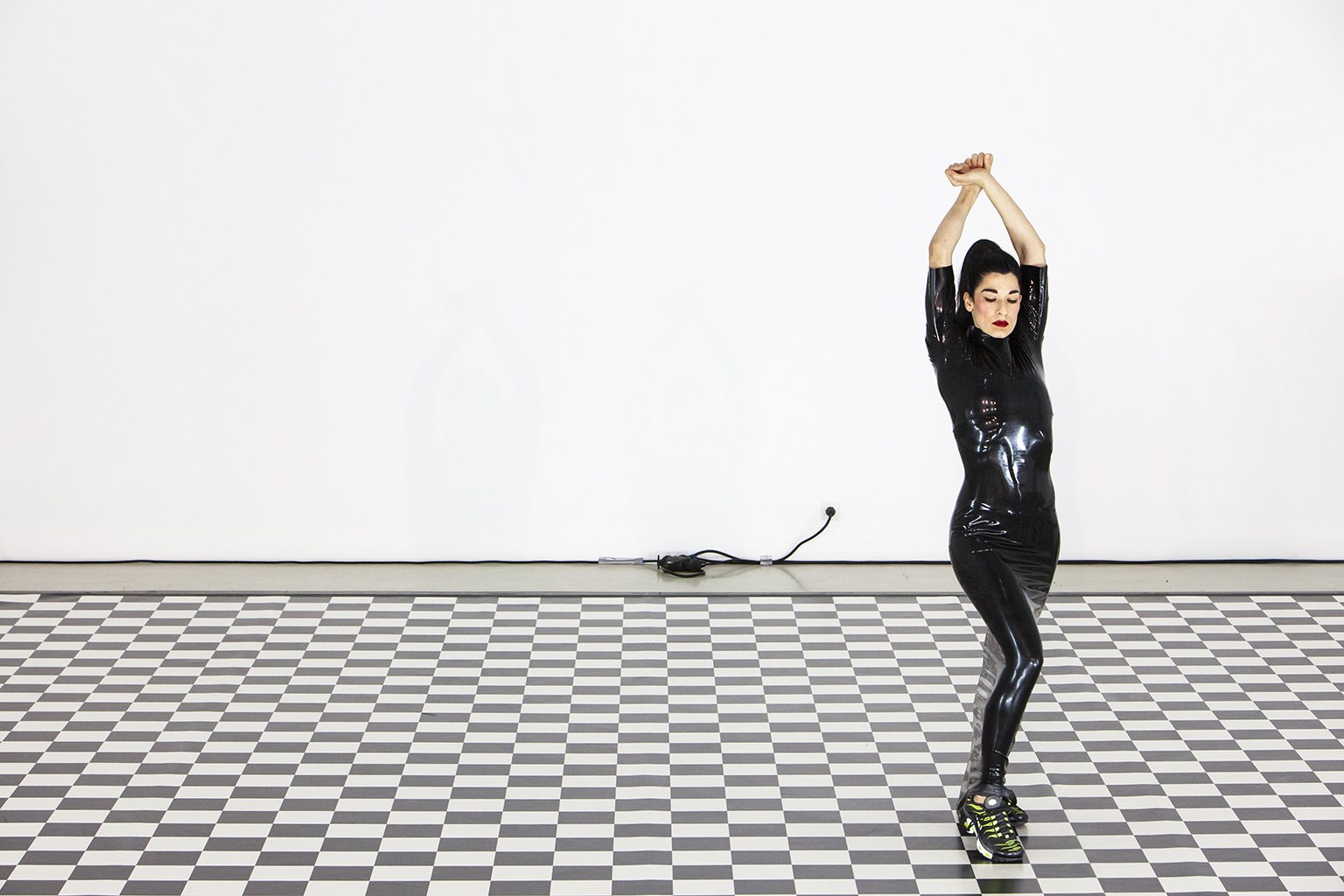Red wine from a box in a plastic cup. Sitting on a mismatched assortment of chairs on risers with a sprinkling of other audience members, some whom I know, some I don’t.
The space is amazing – checkered mylar flooring and thick black theater curtains demarcate the performance space. A far cry from the gutted former RIMI Grocery store that it was when I visited last year. Warmer too…
I chat with an artist sitting to my left. We both feel that this could be another city – The Kitchen in New York comes to mind, various underground performance venues in Berlin…
The artist sits on a small stool stage left.
Sexy sporty fresh
Amy Whinehouse in sneakers
No time for full sentences now
“When I see you baby I just want to take off your clothes, take off your clothes, take off my clothes, rip off your cloths…” the music blares.
Reminder: look up this song when I get home
(Note: The song is Take Off Your Clothes by Morningwood)
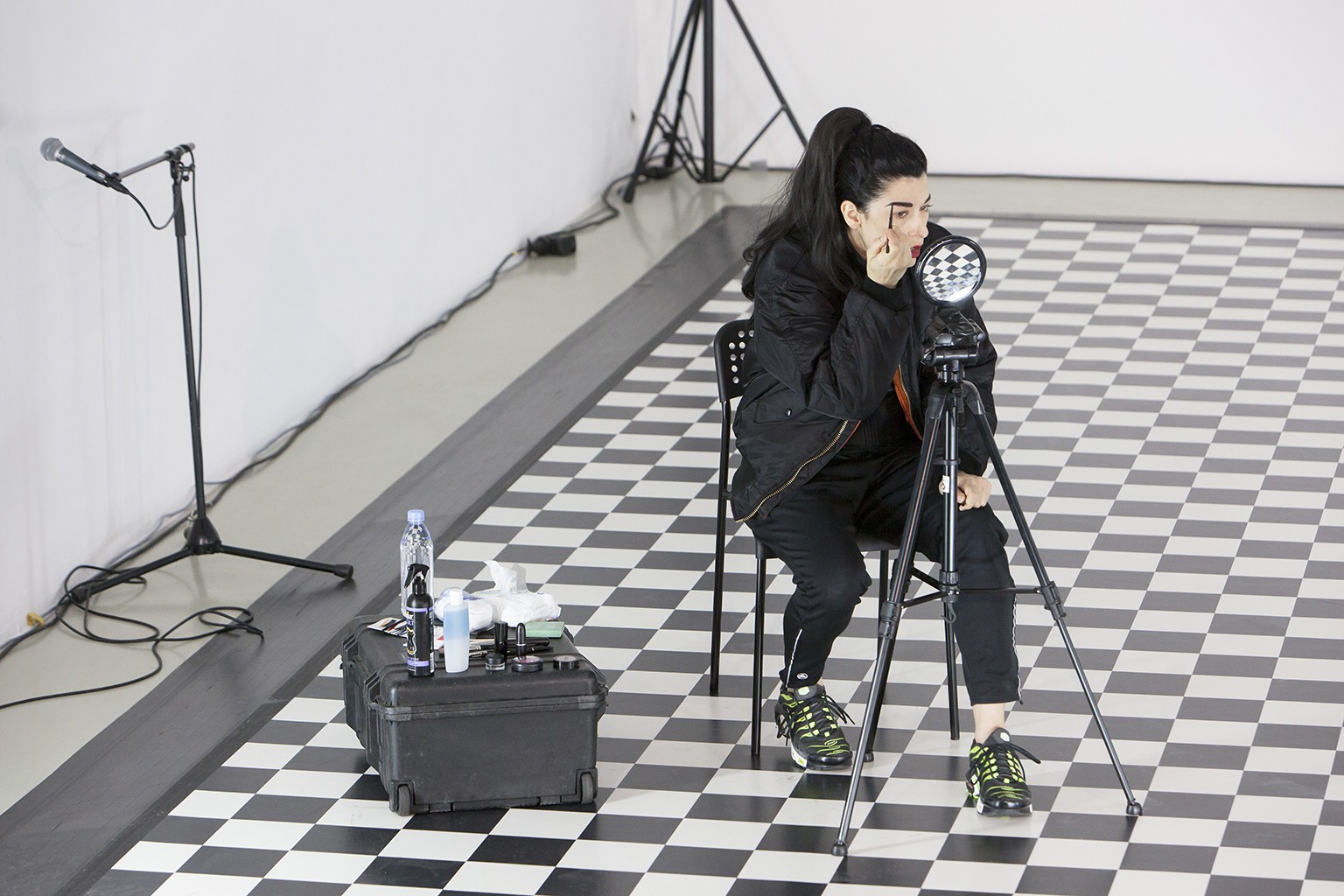
Alexandra is still sitting, laser-focused, putting on make up in front of a small cosmetic mirror on a tripod. It’s a ritual any female who has spent hours getting ready could understand. Put it all on…take it off so it “looks natural”… put a little more on.
Puffs of powder catch and glitter in the bright stage lights
Pucker, hollow cheeks, look left, look right, smile coyly at the reflection
She’s wearing a full-length black latex dress, simultaneously revealing and covering
She asks an audience member to spray latex oil all over, all over she says again…
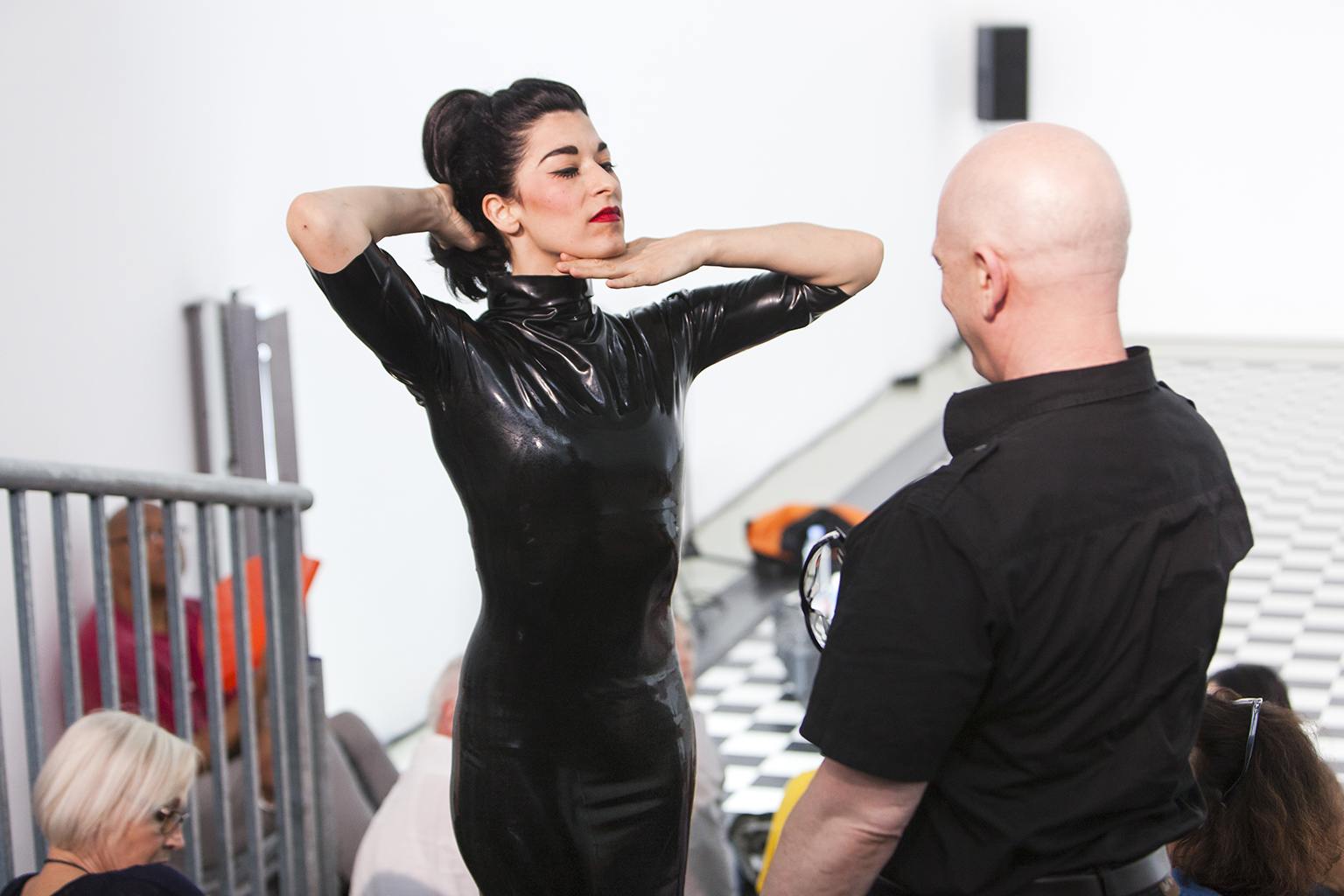
My thoughts scitter too quickly to write:
Gaze
Stripper
artifice
Martha Graham
Bettie Page
Trisha brown
Fetish
Body undulations turn to push-ups and she’s suddenly powerful
Now classic ballet stretches
Sudden silence, creaking chairs, a cough, continued dancing in the ensuing awkward silence
The squeak and slap of the latex renders the previously sexy movements absurd – like a movie suddenly devoid of its soundtrack.
Sauntering towards me. Will she ask me to put my notebook away?
“Could you unzip my dress please?” she asks me politely, turning around and pull her trailing black hair out of the way.
It takes me two tries.
Now my hands are slippery from the oil as I grip my pen. That’s what you get for sitting in the front row.
She removes her make up now – a bit of a shame after all of the previous effort
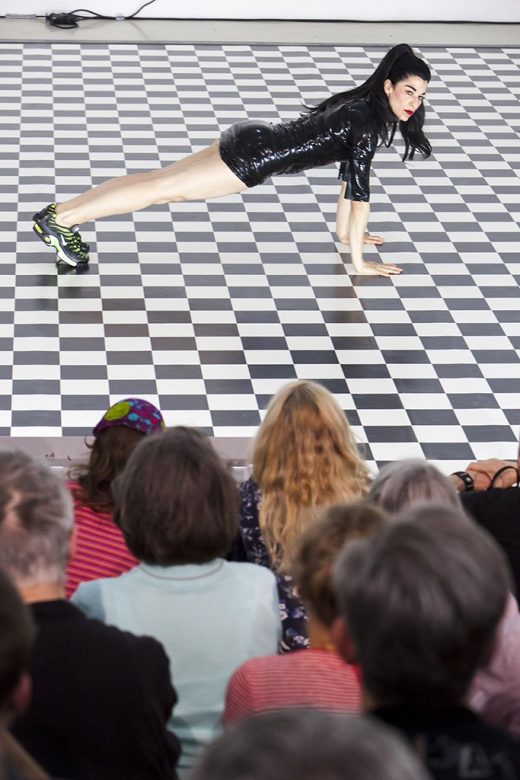
(she quietly announces that the bucket of water has been forgotten – a young man unobtrusively brings it out later during the performance)
Now in pants she becomes, shifting quickly…
athlete
siren
manspreads
beckoning then staring blankly then challenging
with make up and body language, gender changes completely within seconds
tacit agreement of the audience to sit comes to the front: to be challenged
shifts again – jock turns to intellectual
female sex symbol turns male sex symbol
male Calvin klein underwear model, lounging alluringly with an I don’t give a fuck but I really do give a fuck attitude
unhurried movements and long pauses allow for a full gaze and study of posture
The awkwardness now of a female bikini model in an Everlast jumpsuit
a boxer
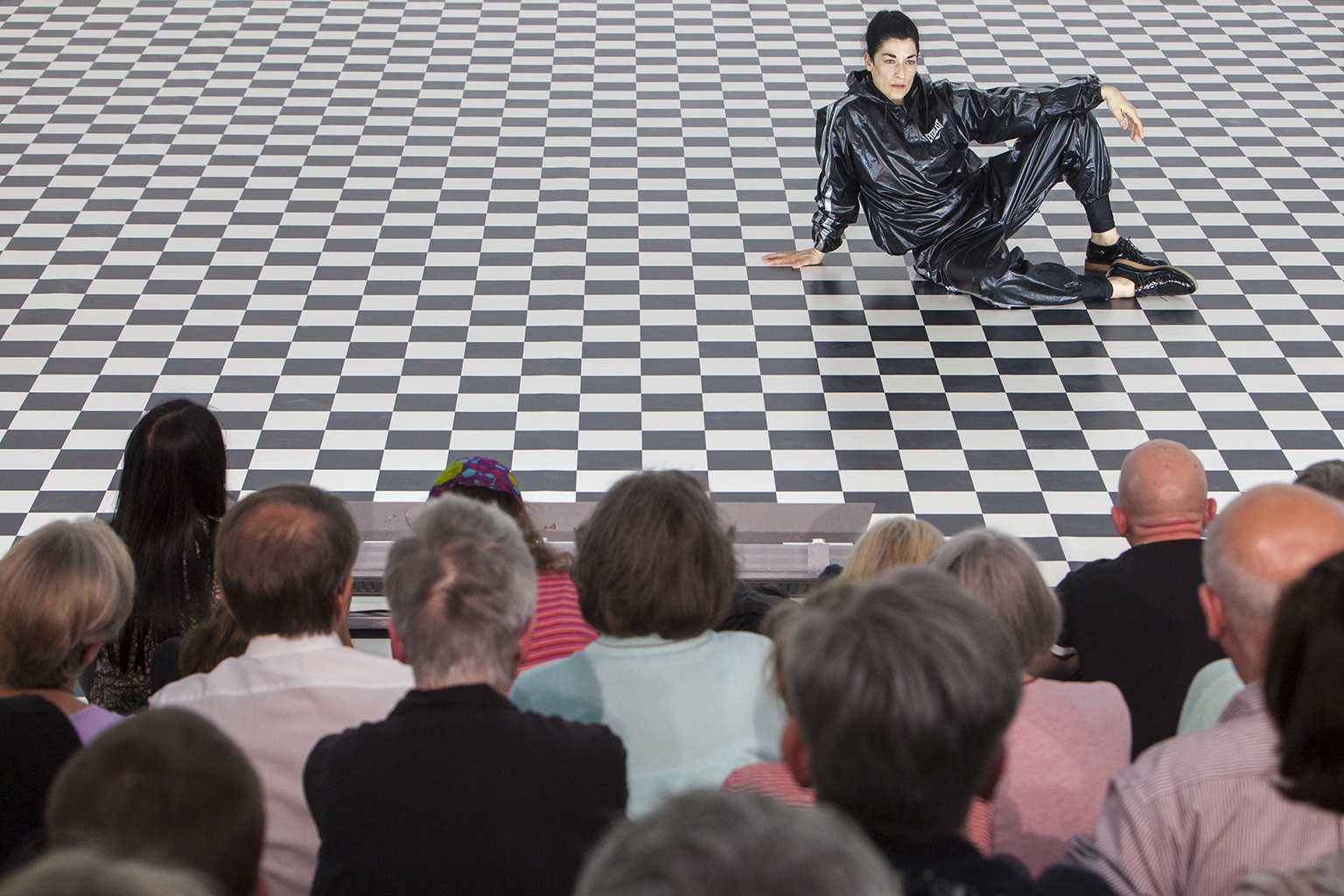
fantasy sleep vs. real sleeping positions: pointed toes and alluring side position becomes a tossing of the head, believable slack-jawed open-mouthed sleep
Trisha Brown’s study of banal everyday movements likes sitting and walking and eating spring to mind.
cow, cat, cow, cat, yoga pose – quickly now
This is challenging and funny – Am I allowed to laugh? She looks so serious gyrating on the floor.
Again she moves with the startling swiftness between stereotypical gender representations.
She dons white socks and just like that we’re in the presence of Michael Jackson and Bob Fosse.
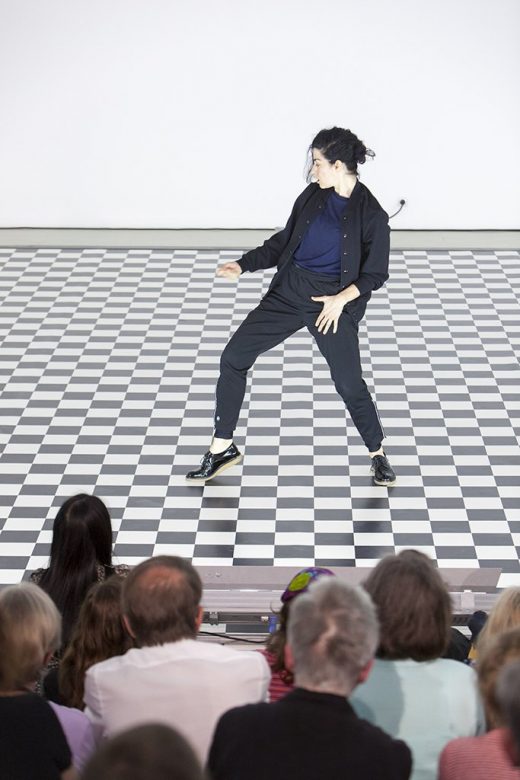
Glaring
tough
inviting
accusatory
promiscuous
alluring
fey
conspiratory
She shows a superb mastery of the subtleties of human gesture
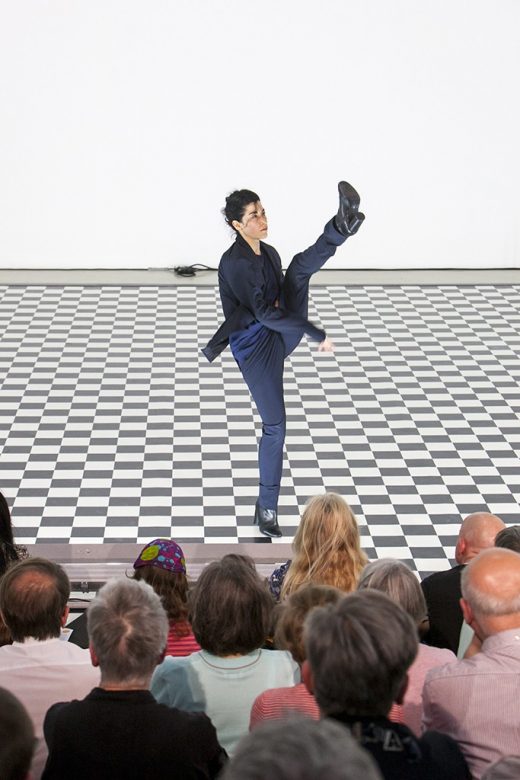
The entirety of the performance feels like a meditation on human movements, body language, costume, gender – both by the artist in the creation of the work and now by us, the audience. It’s a performance of human performance. After all, we’re all trained to perform our various identities, aren’t we?
Now the swing and hold and straight edges of modern dance
Another costume change: business suit and heels.
I’m surprised – the sexy business woman that I expected is now a male flamenco dancer.
heel taps, tow drags and snaps
Suddenly, again, my interpretation of male and female are challenged by shifting into cultural norms.
(Later, reading more about Backzetsis’ practice, I learn this is a reference to the Greek rebetiko tradition.)
….This space, the space for this kind of performance work, is what Stavanger has been missing, what I’ve been missing, perhaps without even know it.
Powerful and intense
Raw but flawless
Now she dunks her head unceremoniously in a bucket of water
Walking without drama back to the original chair, stage left, from where she started her performance.
She’s singing a soulful song – what language is that?
Hair dripping on a wet white towel and blue teeshirt with growing water marks.
This might sound funny in writing, but it isn’t. It’s incredibly moving.
Dripping water
Dripping water
Dripping water
Silence
And then long minutes of hearty, well-deserved applause.
Alexandra Bachzetsis is a choreographer and visual artist, based in Basel (CH) and Zurich (CH). Her practice unfolds at the intersection of dance, performance, the visual arts and theater, generating a conflation of the spaces in which the body, as an artistic and critical apparatus, can manifest. This fundamentally interdisciplinary approach is reflected in her educational background. She studied and graduated at the Zürcher Kunstgymnasium (CH), the Dimitrischule in Verscio (CH), the Performance Education Program at the STUK arts centre in Leuven (BE), and then continued to post-graduate level at Das Arts, the Advanced Research in Theatre and Dance Studies centre in Amsterdam (NL). During these years of training, Bachzetsis began to work as a dancer in the contemporary dance and performance context, collaborating with Sasha Waltz & Guests (Berlin) and Les Ballets C. de la B. (Gent), among others. Collaboration, transference and a plurality of voices and bodies have informed Bachzetsis’ work ever since and is often thematized as a method of developing new work in her practice.
Much of Bachzetsis’s work involves choreographies of the body and, in particular, the way that popular culture provides source material for gesture, expression, identification, and fantasy as we continually create and re-create our bodies and the way we identify. Within this, she scrutinizes the mutual influence between the use of gesture and movement in the ‘popular’ or ‘commercial’ genres on the one hand (online media, video-clip and television as a resource) and in the ‘arts’ on the other hand (ballet, modern and contemporary dance and performance). For Bachzetsis, the artificial and often precarious relationship between such genres produce an inquiry into the human body and its potential for transformation, however conceptual or actual. Ultimately, the way we all perform and stage our bodies and ourselves – through stereotypes and archetypes, through choice and cliché, through labor and spectacle – is a question that continues to shape the work of Bachzetsis.
Since Bachzetsis started working independently in 2001, she has created over 24 pieces, often working collaboratively, which have been shown in theaters, festivals and public space venues worldwide. In addition to this, her work has been exhibited in a variety of contemporary art spaces and museums, including Kunsthalle Basel (Basel, 2008), the Stedelijk Museum (Amsterdam, 2013 and 2015), Tate Modern (London, 2014) and the Jumex Museum (Mexico City, 2014), as well as a number of international biennials, such as the 5th Berlin Biennial (Berlin, 2008), (d)OCUMENTA 13 (Kassel, 2012) the Biennial of Moving Images (Geneva, 2014), the Museum of Modern Art New York (New York 2017) and documenta 14 (Athens and Kassel 2017). Bachzetsis was nominated for the DESTE Prize (2011) and is a laureate of the Migros Kulturprozent Jubilee Award (2007), the Swiss Art Award (2011 and 2016) and Swiss Performance Prize (2012). In 2016, Brachzetsis participated in “The Parliament of Bodies” and “Continuum”, Public Programmes at documenta 14. In January 2017, she presented Massacre: Variations on a Theme at MoMA, New York City. Later that year her work was included in documenta 14 exhibitions at Athens and Kassel.
Learn more about the artist on her website, HERE.


